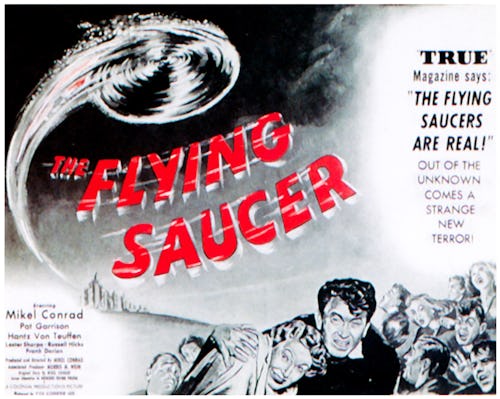
When we think of the “flying saucer” film, we typically picture sci-fi terrors from the 1950s like Earth vs. the Flying Saucers, The Day The Earth Stood Still, and even War of the Worlds. It was an extremely popular subgenre at the time, and theaters were chock full of tales of mankind being threatened by spaceships shaped like dinner plates. But what is perhaps the first entry in the “flying saucer” genre is a far cry from what was to come: 1950’s The Flying Saucer isn’t about visitors from outer space — instead, it aims at replicating real world nightmares, and turning the paranormal into the paranoid.
The late 1940s had seen the craze over the flying saucer reach a fever pitch. People had reported seeing “unidentified flying objects” for centuries, but after World War II, it bloomed into an outright international obsession. This interest combined a lot of factors, the renewed popularity of science fiction in a post atomic world chiefly among them.
But also notable was the fear of foreign technology, only heightened by America’s plummet into another “Red Scare.” The Truman Doctrine and other measures had taken aim at not just the Soviet Union from the outside, but what many Americans felt was a communist uprising from within. And nothing represented those anxieties on a mechanical scale quite like the flying saucer — a sleek, emotionless vehicle that was antithetical to what we knew of flying craft in the United States. Were they aliens from another planet planning for a global takeover? Dirty communists from across the world looking to spy on us? Considering the deranged highs achieved by this shared fascination, it was hard to tell them apart.
The Flying Saucer sought to comment on these blended fixations. It tells the story of rich playboy Mike Trent (played by Mikel Conrad, also the director) who, teaming with Secret Service agent Vee Langley, is tasked by American Intelligence to investigate reports of a flying saucer in Alaska. They soon discover that the saucer’s creator is actually an American scientist, but his assistant is in connection with the Soviets, thus beginning a series of espionage-fueled encounters that place any science-fiction thrills in the backseat. Instead, The Flying Saucer zooms in on the burgeoning psychological warfare of the Cold War, and its stolen secrets and double agents.
It’s easy to see why The Flying Saucer isn’t as well-remembered as the more fantastical films to follow. The writing is scattershot — the Americans obviously have the moral and intellectual high ground in any situation, but they’re also easily betrayed to a cartoonish extent, only realizing the subterfuge when it’s staring them in the face. There’s also not much spectacle to speak of — you gain more appreciation for scenic shots of the Alaskan wilderness than any special effects prowess. In the end, the Soviets are killed by an avalanche and the titular flying saucer blows up in midair due to a planted explosive, the result of which only garners a mild gasp from Vee Langley.

But though The Flying Saucer would disappear a few years after its release and its spot in pop culture was replaced by much more crowd-pleasing efforts, it did lay the seeds of a genre. A year later, The Day The Earth Stood Still would capture the rising tension of the feeling that the Earth was a button-push away from destruction, either from its own inhabitants or those from space. Two years after that, War of the Worlds would adjust H.G. Wells’ original novel to fit the times, with an unfeeling enemy that might only be conquered with mutual nuclear destruction (though an atom bomb turns out to be of no use here). 1956’s dual offerings of Earth vs. The Flying Saucers and Japan’s Fearful Attack of the Flying Saucers (the latter directed by original Godzilla writer Shinichi Sekizawa) both reflect Cold War morbidities.
Invaders from Mars, The Thing from Another World, and others joined in, many of which turned The Flying Saucer’s plain-spoken anxious text into a subtext more palatable for the kids munching popcorn in the audience. Such was the path of the sci-fi laden ‘50s. Alongside the “flying saucer” genre was the “giant monster” genre, and what started with potent odes to nuclear doom like Godzilla quickly devolved into a parade of enormous lizards and bugs trying to devour the countryside.
However, one can find hints of something more culturally profound in The Flying Saucer. It is, by no means, an underrated or undiscovered classic, so filled as it is with exhausting dialogue and shots that look like they could’ve come out of a commercial for an Alaskan Airbnb. But in a low-rent way, it stays true to something that had seeped into parts of America’s collective consciousness — that we were not alone in the world and that something, be it spacecraft or Soviets, was watching us, either from within our midst or far, far up above.
FTTT
0 Comments